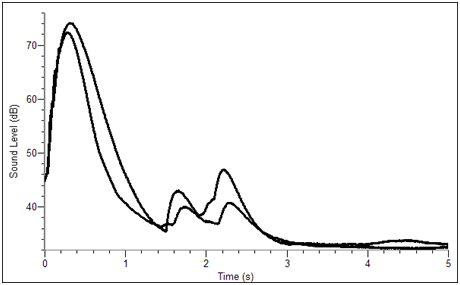One goal of acoustic engineers is to “tune” a room for a specific purpose. A room tuned for lecture will be tuned differently than a library. The Sound Level Meter can be used to investigate acoustics in a room. One of the indicators of good room acoustics is the length of time sound stays in the room. Hard surfaces in a room allow sound to “reverberate” for relatively long periods of time. Soft surfaces dampen the reverberation. For example, if you clap your hands in an empty gymnasium, you will hear a relatively long echo. Repeat the experiment in a library, music room, or concert hall, and you will hear a shorter echo. Use the Sound Level Meter and a computer or calculator to try this experiment:
- Set the equipment up to collect data for 5 seconds.
- Use the triggering feature of the software so the data collection is initiated with a loud sound.
- Collect a set of data and examine the graph.
- Determine how long it takes the sound level to fall by a specific dB level from the peak level.
- Repeat the experiment in a different room.
In this example, room acoustics were investigated in a sound booth and in a large room with hard, flat surfaces. Two boards were struck together to produce a loud sound. The sound level in the sound booth dropped 20 dB in 0.35 s. In the room with bare walls, it took 0.51 s for the sound level to drop 20 dB.

